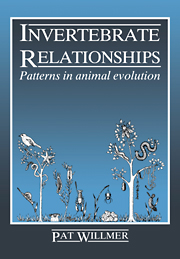Book contents
- Frontmatter
- Contents
- Acknowledgements
- Part I Introduction to animal phylogeny
- Part II Sources of evidence in invertebrate phylogeny
- Part III Phylogeny of major groups
- 7 The origin of the Metazoa
- 8 Acoelomates and other lowly worms
- 9 The pseudocoelomates
- 10 The phylogenetic position of molluscs
- 11 Arthropod phylogeny
- 12 The deuterostomes
- 13 The lophophorates
- 14 A phylogenetic overview of invertebrates
- References
- Index
7 - The origin of the Metazoa
Published online by Cambridge University Press: 08 January 2010
- Frontmatter
- Contents
- Acknowledgements
- Part I Introduction to animal phylogeny
- Part II Sources of evidence in invertebrate phylogeny
- Part III Phylogeny of major groups
- 7 The origin of the Metazoa
- 8 Acoelomates and other lowly worms
- 9 The pseudocoelomates
- 10 The phylogenetic position of molluscs
- 11 Arthropod phylogeny
- 12 The deuterostomes
- 13 The lophophorates
- 14 A phylogenetic overview of invertebrates
- References
- Index
Summary
Introduction
The origin of multicellular animal life from single-celled ancestors is perhaps the most enigmatic of all phylogenetic problems, and the least likely to be ‘solved’ by additional evidence from any of the sources already discussed. Most obviously, it remains completely obscure in terms of the final arbiter of a fossil record. The issues with which this chapter is concerned are therefore inevitably highly speculative and any treatment of them is bound to be unsatisfactory. Nevertheless this area is gradually becoming amenable to a more synthetic approach, and it is now possible to bring together some of the problems already raised in part 2, since increasing knowledge of cell biology and biochemistry is beginning to give a fresh perspective to these murky areas of zoology. This is also an area where an increasing stress is being laid on the necessity of proposed ancestors being functionally plausible, and of stages in their evolution having obvious selective advantage, so that some early theories are gradually losing support.
The problem of metazoan origins has naturally exercised the imaginations of invertebrate biologists, and many theories have been advanced in the last 150 years. Most of these have been compounded with views on subsequent evolution from the earliest metazoan to the groups of existing lower Metazoa, and on relationships between these various phyla (particularly sponges, cnidarians and platyhelminths). In fact it is difficult to separate these issues, as any theory of the nature of the first multicellular animals inevitably has consequences for conceptions of ‘what happens next’.
- Type
- Chapter
- Information
- Invertebrate RelationshipsPatterns in Animal Evolution, pp. 163 - 198Publisher: Cambridge University PressPrint publication year: 1990
- 1
- Cited by



